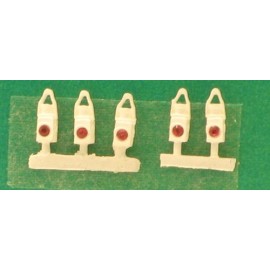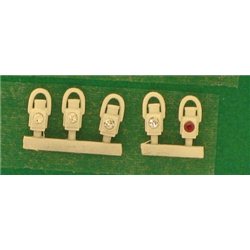Mainline Railways was a British model railway brand that operated between 1976 and 1983, introduced by Palitoy, the...
No products
Product successfully added to your shopping cart
There are 0 items in your cart. There is 1 item in your cart.
Search Tips
Open on Good Friday
The shop will be open on Friday 18th April.
Bring us some chocolate!
What is a train tail lamp?
Tail lamps on trains have been around since the 1800s, originally powered by oil and later by batteries, they consist of a red lamp or flashing light attached to the very rear of a train to warn other trains of their presence. The first rules governing the use of tail lamps were introduced by the Railway Clearing House way back in 1867, there have been numerous updates and amendments to the guidance for their use since then but their basic function remains the same to this day.
Trains must display a tail lamp at the very rear of the train, this is because in the early days, breakages in couplings were commonplace and if a train was witnessed running without a tail lamp, then it would be assumed by the signalman that the rear section of it had broken away and appropriate action could be taken. For the same reason trains once displayed further lights on the side of their brake vans too, with red lights facing backwards and white lights facing forward, this was so that locomotive crews could check back along the train to see if the back of it was still attached!
With the introduction of better couplings the side lamps were gradually phased out, but interestingly, whilst they were still in use there where certain circumstances when they were used to show a white-light facing backwards instead of a red one, this eventuality would occur when a slow train was travelling along a slow line with a faster line running parallel and in the same direction. An overtaking express could conceivably see the tail lights up ahead and mistake it to be a train on the same track (potentially the back section of a train that has broken away). To avoid this panic-inducing confusion, the side lamp immediately next to the faster line would display white light with the remaining side and tail light displaying red to indicate that all is well.
Because of the significance of the tail lamps, it is also not permitted for a tail lamp to be displayed or even attached to the train's consist anywhere other than the rear of it to avoid confusion. There have been incidents where a forgotten tail lamp attached within a consist has resulted in the train being stopped by signallers and train crews having to not only remove the offending lamp but also carry out a full inspection of the train before the train was allowed to proceed.
There was also a brief period in history where the rules regarding tail lamps didn't quite keep up with technological advancements, and although DMUs were being introduced with tail lights incorporated into their design, the rules stated that a tail light must be attached so in the early day it was not uncommon to see a multiple unit dressed with a tail lamp attached to its rear end, even the Blue Pullman had lamp irons fitted!
Tail lights may only be a small part of a train, but they are a really important one!
Click here to receive the tips weekly in your mailbox. You can unsubscribe at any time.










